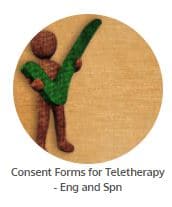Teletherapy Speech Language Evaluations
There are a few things we need to consider to be able to undertake a teletherapy speech language evaluation and make diagnostic decisions wisely. We need:
- Information from the test developers and ASHA about telepractice assessments to assure we are doing the right thing
- Adaptability: how to use the tests we have without buying a second set of digital speech and language assessments
- Examples! We really need video examples! Don’t tell me; show me how to do it.
- Support to alter our virtual testing prompts and still get useable results
- Ideas for working with parents to help us get great results
By watching the following videos you will be well on your way to having the confidence and knowledge to accurate conduct speech language evaluations via teletherapy.
Can we conduct formal speech language evaluations via teletherapy?
When the pandemic first hit, many school districts and clinics made decisions to postpone speech-language assessments until face-to-face life returned. It quickly became apparent that evaluations could not be put on hold indefinitely. And the truth is, we CAN effectively conduct most speech-language evaluations remotely.
If you have had any questions about telepractice speech language evaluations you are in the right place. These videos will walk you through the different aspects of teletherapy speech language evaluations to get you up and running.
Using Standardized Speech Language Tests for Assessment via Telepractice
Dr. Ellen Kester of Bilinguistics interviews Dr. Elizabeth Allen of Pro-Ed. They discuss the use of standardized tests during telepractice assessments, the use of norms, and what Pro-Ed is doing to make tests more accessible to speech-language pathologists conducting remote testing.
Don’t Wait to Do Online Speech Language Evaluations. An Interview with Dr Elizabeth Peña, author of the BESA.
Dr. Ellen Kester of Bilinguistics and Dr. Elizabeth Peña of the University of California-Irvine discuss why speech and language testing can’t wait until we are back in school. They discuss studies indicating reliability across teletherapy compared to in-person speech therapy, the use of standardized scores in remote testing, and tips for implementing remote speech-language evaluations that yield confident diagnostic decisions.
Using Document Cameras for Telepractice Speech-Language Evaluations
When the global pandemic first hit and we received letters from publishing companies granting us temporary permission to administer tests over videoconferencing platforms, we all scratched our heads and thought, “How is that going to work?” “How do I use a document camera for speech-language evaluations?” Watch this to see how to use a document camera for speech evaluations easily and inexpensively.
Telepractice and Informal Speech Language Assessment
As with any in-person evaluation, our remote evaluations should always incorporate language samples. In this video, we used our Mercer Mayer book Frog, Where Are You? to get a language sample without a model. We then provided a teaching session and got another language sample following the teaching session. So not only do we get great language sample information, this is also our dynamic assessment that helps us look at change with teaching, or learning potential. We followed it up with some informal receptive language tasks using story comprehension questions. This is rich information to guide our diagnostic decisions.
Teletherapy Articulation Assessment
In this video, two of the authors of the Bilingual Articulation and Phonology Assessment app, walk through the simple process of plugging the iPad into the computer to administer the BAPA over a teleconferencing platform. The test is administered EXACTLY as it is when sitting face-to-face.
Telepractice Articulation Assessment Example
This video shows how the BAPA displays on the screen, and how prompts are played. You need to be sure you check the “Share computer audio” button for the audio prompts to play clearly for your students and clients.
Telepractice Informal Assessment of a Two-Year-Old
This 4-minute video on informal assessment is PACKED with great ways to gather the information you need. This 2-year-old commented, pointed to objects, colors, and body parts on request, expanded his utterances in response to an expanded language model, engaged in turn-taking, and used social greetings. The powerful information we get from informal assessment practices informs confident diagnostic decisions.
French-English Evaluation with Parent Support
Dr. Ellen Kester demonstrates how to conduct a French-English speech evaluation with parent support.
Writing Up a Teletherapy Speech Language Evaluation
Lastly and possibly most importantly there are some critical statements that we need in our reports to describe what took place during the teletherapy speech language evaluation. The first is that we have to highlight the situation and considerations that were taken to gather the data. Here is an example:
CONSIDERATIONS FOR ASSESSMENT VIA TELEPRACTICE:
Due to the current COVID-19 pandemic, telepractice was utilized for this assessment to ensure the health and safety of all individuals involved. This evaluation was conducted online using live, interactive video conferencing using the Zoom platform. Both parties met the minimum Internet connection speeds to support the desired audio and video quality and testing was performed in a quiet space with appropriate lighting and the full face of the client appeared in the video throughout the evaluation.
We also want to describe any behavior that would be different from a regular testing session. We aren’t necessarily talking about the student’s behavior here but how well he participated, if we had to give breaks, how the testing session went. Here is an example:
BEHAVIOR DURING TESTING/TESTING OBSERVATIONS
Student was very active throughout the two testing sessions, which were conducted via videoconferencing due to the Covid-19 Shelter-in-Place order. He was able to participate in testing for 15-20-minutes at a time with breaks in between. During the breaks, he swung in a hammock, ran in his yard, and interacted with his sister. When portions of the test did not require him to sit and look at the screen, he was permitted to stand up. He was talkative and friendly throughout the evaluation. He needed moderate-to-frequent verbal prompts to maintain his attention to the testing tasks. He was redirected by the speech-language pathologist and his mother.
MODIFICATIONS DURING THE TELETHERAPY SPEECH LANGUAGE EVALUATION
Lastly, we want to describe how our testing was modified. Imagine if someone else had to give the same test and try to get the same results. What would you have to explain to them?
If we administer a sub test and we have to do a modification throughout that sub test, we need to describe it. And, I think that it’s important for us to go one step further and write about like what impact we think that that modification could have on the testing.
For example if we asked the child to point to two things at the same time on the screen. What if we are using a system where he was not able to do that? He couldn’t show us two things at the same time. You would need to explain that he pointed at one thing and then the other.
We can conduct speech-language evaluations remotely with fidelity.
Learning how to do a teletherapy speech language evaluation can feel overwhelming. It’s not just the modified testing, it’s the technology, the new systems, the delayed wait time, the interaction with the other adult on the other side… So we want to leave you with this: every family that we have worked with has been grateful for the effort and care that we were broadcasting into their home. They are in the same boat too and it is great to make a connection and interact with someone who is trying to help. While we have to work through some platform differences, you can see from these videos that we can still gather qualitative data and implement standardized measures during virtual speech and language assessments that give us solid data we can use to make confident and accurate diagnostic decisions.
Links to More Articles and Further Reading
Consent Forms for Teletherapy – Eng and Spn
Tips for Teletherapy Receptive Language Items
Using Document Cameras for Speech-Language Evaluations
How to Use Zoom for SLPs – DOs and Crucial DON’Ts
Teletherapy with Young Children : Great Resources
Dr. Elizabeth D. Peña, University of California, Irvine


